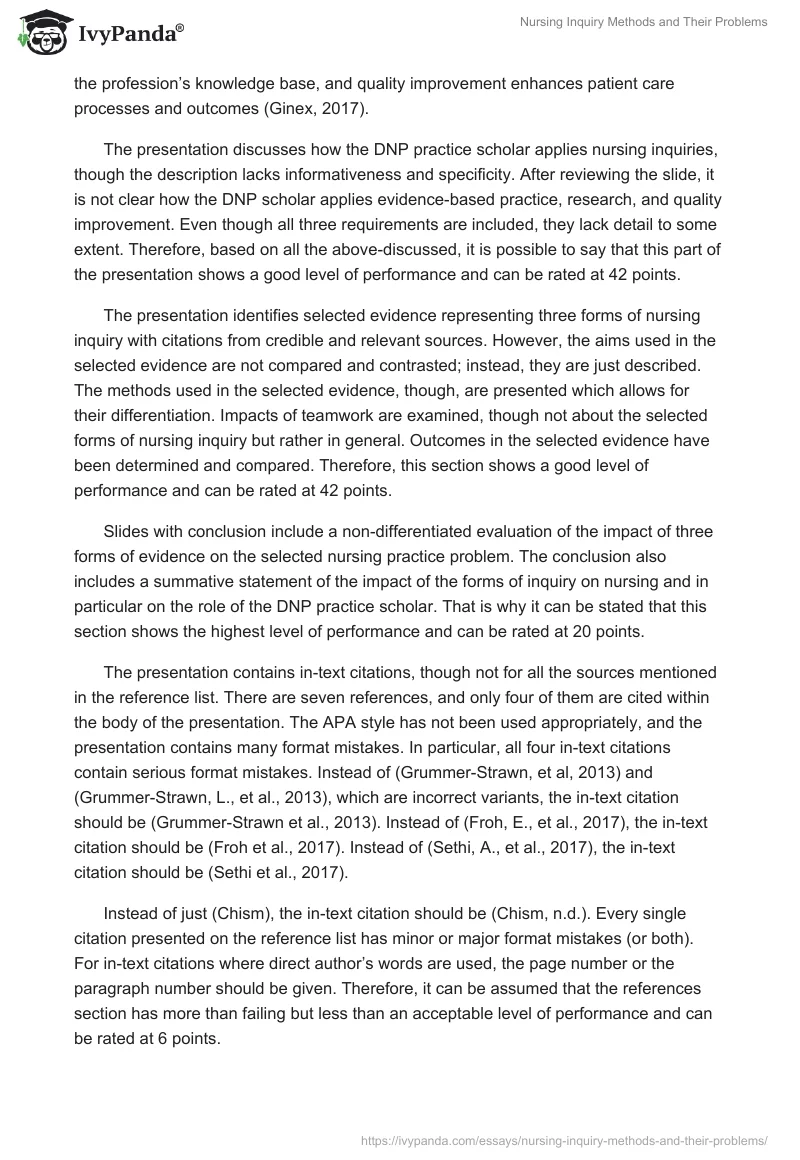The introduction of the presentation consists of two slides that clearly describe the purpose of the further analysis and determine the nursing problem which should be addressed using the selected methods of nursing inquiry. Both the significance and scope of the identified nursing problem were included in the introduction part. Since all three requirements are presented in the introduction, it is possible to state that this section shows the highest level of performance and can be rated at 20 points.
In the main part of the work, three forms of nursing inquiry, which are evidence-based practice, quality improvement, and research, are presented. Purpose, method, and outcome are given for each form of nursing inquiry, which allows for saying that the forms are briefly compared and contrasted in terms of these three criteria. However, one may note that minor corrections should be made to identified aims, methods, and outcomes. In particular, the aim of evidence-based practice is not just to identify a gap in best evidence but also to find and translate the evidence to apply it to clinical decision-making. Such a definition would be more helpful in differentiating between research and evidence-based practice.
One could suggest mentioning that unlike research and evidence-based practice, quality improvement does not require a critical appraisal or vast literature review, which is why this inquiry is the most typical for nurses. It would be appropriate to note that the aim of the research is not only to identify a gap in evidence but also to generate new knowledge. It is not quite clear what is the difference between quality improvement and research. It would be advisable to add that quality improvement is focused on improving the process of care delivery, whereas research is aimed at generating new knowledge or advancing the existing one.
The impacts of each form of nursing inquiry are discussed. However, it should be stated that the information given is not clear and does not allow for a thorough understanding of the effect of evidence-based practice, quality improvement, and research on nursing practice. It would be more feasible to mention that research adds to the profession’s knowledge base, and quality improvement enhances patient care processes and outcomes (Ginex, 2017).
The presentation discusses how the DNP practice scholar applies nursing inquiries, though the description lacks informativeness and specificity. After reviewing the slide, it is not clear how the DNP scholar applies evidence-based practice, research, and quality improvement. Even though all three requirements are included, they lack detail to some extent. Therefore, based on all the above-discussed, it is possible to say that this part of the presentation shows a good level of performance and can be rated at 42 points.
The presentation identifies selected evidence representing three forms of nursing inquiry with citations from credible and relevant sources. However, the aims used in the selected evidence are not compared and contrasted; instead, they are just described. The methods used in the selected evidence, though, are presented which allows for their differentiation. Impacts of teamwork are examined, though not about the selected forms of nursing inquiry but rather in general. Outcomes in the selected evidence have been determined and compared. Therefore, this section shows a good level of performance and can be rated at 42 points.
Slides with conclusion include a non-differentiated evaluation of the impact of three forms of evidence on the selected nursing practice problem. The conclusion also includes a summative statement of the impact of the forms of inquiry on nursing and in particular on the role of the DNP practice scholar. That is why it can be stated that this section shows the highest level of performance and can be rated at 20 points.
The presentation contains in-text citations, though not for all the sources mentioned in the reference list. There are seven references, and only four of them are cited within the body of the presentation. The APA style has not been used appropriately, and the presentation contains many format mistakes. In particular, all four in-text citations contain serious format mistakes. Instead of (Grummer-Strawn, et al, 2013) and (Grummer-Strawn, L., et al., 2013), which are incorrect variants, the in-text citation should be (Grummer-Strawn et al., 2013). Instead of (Froh, E., et al., 2017), the in-text citation should be (Froh et al., 2017). Instead of (Sethi, A., et al., 2017), the in-text citation should be (Sethi et al., 2017).
Instead of just (Chism), the in-text citation should be (Chism, n.d.). Every single citation presented on the reference list has minor or major format mistakes (or both). For in-text citations where direct author’s words are used, the page number or the paragraph number should be given. Therefore, it can be assumed that the references section has more than failing but less than an acceptable level of performance and can be rated at 6 points.
Speaking of the PowerPoint requirements, not all of them have been followed. The number of slides is 16, which corresponds to the required limit of 10-20 slides. The presentation has a good general appearance and mostly follows the 6×6 rule, except for several slides, where in-text citations are used and nursing inquiries are compared and contrasted. There are minor grammar, capitalization, and punctuation mistakes in the presentation. That is why it can be stated that in terms of PowerPoint requirements, the work has a fairly good level of performance and can be rated at 17 points. Summarizing points per each criterion, the total number of points is 147. To conclude, the presentation has a good level of performance, though serious citation mistakes have been detected.
Reference
Ginex, P. K. (2017). The difference between quality improvement, evidence-based practice, and research. Web.



